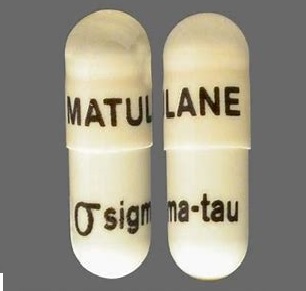Procarbazine Dosage
Medically reviewed by Drugs.com. Last updated on Sep 1, 2025.
Applies to the following strengths: 50 mg
Usual Adult Dose for:
Usual Pediatric Dose for:
Additional dosage information:
Usual Adult Dose for Hodgkin's Disease
As a single agent:
- Initial dose: Single or divided doses of 2 to 4 mg/kg/day orally for one week (to minimize the nausea and vomiting experienced by a high percentage of patients beginning therapy)
- Maintenance dose: 4 to 6 mg/kg/day orally until maximum response is obtained or until the white blood count falls below 4000 or the platelets fall below 100,000; when maximum response is obtained the dose may be maintained at 1 to 2 mg/kg/day orally
- Discontinue therapy for hematologic or other toxicity until satisfactory recovery, then resume therapy (at the discretion of the physician based on patient evaluation and laboratory studies) at 1 to 2 mg/kg/day
In combination with other anticancer drugs:
- The dose of this drug should be reduced (e.g., in the MOPP regimen, the dose is 100 mg/m2/day for 14 days)
Comments:
- Dosing given here is manufacturer suggested. Local and institutional protocol should be consulted.
- Doses should be based on the patient's actual weight; however, the estimated lean body mass (dry weight) is used if the patient is obese or if there has been a spurious weight gain due to edema, ascites, or other forms of abnormal fluid retention.
Use: In combination with other anticancer drugs for the treatment of Stage III and IV Hodgkin's disease; this drug is used as part of the MOPP (nitrogen mustard, vincristine, procarbazine, prednisone) regimen
Usual Pediatric Dose for Hodgkin's Disease
Close clinical monitoring is necessary to minimize toxicity (e.g., tremors, coma, convulsions). Dosage should be individualized. The following dosage schedule is provided as a guideline only:
- Initial dose: 50 mg/m2/day orally for the first week
- Maintenance dose: 100 mg/m2/day orally until maximum response is obtained or until leukopenia or thrombocytopenia occurs; when maximum response is obtained the dose may be maintained at 50 mg/m2/day orally
- Discontinue therapy for hematologic or other toxicity until satisfactory recovery, then resume therapy (at the discretion of the physician based on patient evaluation and laboratory studies).
Comments:
- Dosing given here is manufacturer suggested. Local and institutional protocol should be consulted.
- Doses should be based on the patient's actual weight; however, the estimated lean body mass (dry weight) is used if the patient is obese or if there has been a spurious weight gain due to edema, ascites, or other forms of abnormal fluid retention.
Use: In combination with other anticancer drugs for the treatment of Stage III and IV Hodgkin's disease; this drug is used as part of the MOPP (nitrogen mustard, vincristine, procarbazine, prednisone) regimen
Renal Dose Adjustments
Dose adjustment(s) may be required; however, no specific guidelines have been suggested. Caution recommended.
Liver Dose Adjustments
Dose adjustment(s) may be required; however, no specific guidelines have been suggested. Caution recommended.
Dose Adjustments
If during the initial treatment the total white cell count falls to 3000/mm3 or the platelet count to 80,000/mm3, therapy should be suspended temporarily until the leucocyte and/or platelet levels recover, when therapy with the maintenance dose may be resumed.
Precautions
US BOXED WARNINGS:
- This drug should only be given by or under the supervision of a physician experienced in the use of potent antineoplastic drugs.
- Adequate clinical and laboratory facilities should be available to patients for proper monitoring of therapy.
CONTRAINDICATIONS:
- Hypersensitivity to the active component or any of the ingredients
- Inadequate marrow reserve as demonstrated by bone marrow aspiration; due consideration of this possible state should be given to each patient who has leukopenia, thrombocytopenia or anemia
Consult WARNINGS section for additional precautions.
Dialysis
Data not available
Other Comments
Storage requirements:
- Store at 59F to 86F (15C to 30C).
Monitoring:
- Hemoglobin, hematocrit, white blood count (WBC), differential, reticulocytes, and platelets should be monitored at least every 3 or 4 days.
- Urinalysis, transaminase, alkaline phosphatase and blood urea nitrogen tests should be repeated at least weekly.
Patient advice:
- Do not drink alcoholic beverages while taking this drug since there may be a disulfiram-like reaction.
- Avoid foods with known high tyramine content such as wine, yogurt, cheese, and bananas.
- Over-the-counter drug preparations which contain antihistamines or sympathomimetic drugs should be avoided.
- Tell your doctor about all medications you use.
- Discontinue tobacco use.
More about procarbazine
- Check interactions
- Compare alternatives
- Side effects
- During pregnancy
- Drug class: miscellaneous antineoplastics
- En español
Patient resources
Other brands
Professional resources
Other brands
Related treatment guides
See also:
Further information
Always consult your healthcare provider to ensure the information displayed on this page applies to your personal circumstances.


